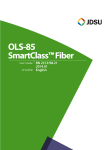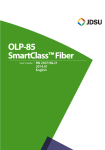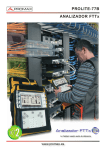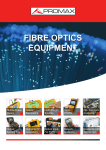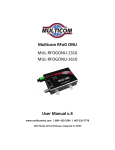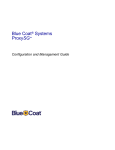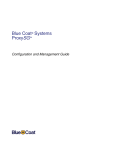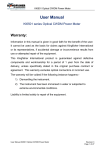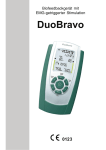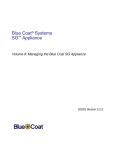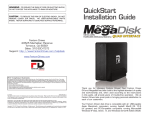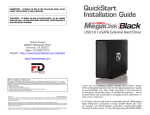Download User`s Guide OLP-37 - Viavi Solutions Inc.
Transcript
Please direct all inquiries to your local JDSU sales company. The addresses can be found at: http://www.jdsu.com/Contact-Us A description of additional instrument features can be found at: http://www.jdsu.com/en-us/Test-and-Measurement/Pages/default.aspx Notice Every effort was made to ensure that the information in this document was accurate at the time of printing. However, information is subject to change without notice, and JDSU reserves the right to provide an addendum to this document with information not available at the time that this document was created. Copyright © Copyright 2015 JDS Uniphase Corporation. All rights reserved. JDSU, “You know us because you depend on our technology every day” and the JDSU logo are trademarks of JDS Uniphase Corporation. All other trademarks and registered trademarks are the properties of their respective owners. JDSU Deutschland GmbH Mühleweg 5, D-72800 Eningen u. A. Order no.: BN 2302/98.12 Version: 2015.01 Previous version: – Notes: Changes may be made to specifications, descriptions and delivery information. CONTENTS CONTENTS INTRODUCTION . . . . . . . . . . . . . . . . . . . . . . . . . . . . . . . . 5 SmartPocket™ test solutions. . . . . . . . . . . . . . . . . . . . . . . . . . OLP-37 optical power meters . . . . . . . . . . . . . . . . . . . . . . . . . Operating manual update . . . . . . . . . . . . . . . . . . . . . . . . . . . . Symbols used in this operating manual . . . . . . . . . . . . . . . . 5 5 6 7 SAFETY INFORMATION . . . . . . . . . . . . . . . . . . . . . . . . . . . 9 Warning symbols on the unit . . . . . . . . . . . . . . . . . . . . . . . . . 9 Proper usage . . . . . . . . . . . . . . . . . . . . . . . . . . . . . . . . . . . . . . . 9 Laser safety . . . . . . . . . . . . . . . . . . . . . . . . . . . . . . . . . . . . . . . 10 Battery operation . . . . . . . . . . . . . . . . . . . . . . . . . . . . . . . . . . 10 Ventilation . . . . . . . . . . . . . . . . . . . . . . . . . . . . . . . . . . . . . . . . 11 GETTING STARTED . . . . . . . . . . . . . . . . . . . . . . . . . . . . . 12 Unpacking the instrument. . . . . . . . . . . . . . . . . . . . . . . . . . . Key pad . . . . . . . . . . . . . . . . . . . . . . . . . . . . . . . . . . . . . . . . . . . Display elements. . . . . . . . . . . . . . . . . . . . . . . . . . . . . . . . . . . Power supply . . . . . . . . . . . . . . . . . . . . . . . . . . . . . . . . . . . . . . 12 15 16 17 GENERAL CONCEPTS . . . . . . . . . . . . . . . . . . . . . . . . . . . 19 Instrument type. . . . . . . . . . . . . . . . . . . . . . . . . . . . . . . . . . . . Main modes . . . . . . . . . . . . . . . . . . . . . . . . . . . . . . . . . . . . . . . Test types . . . . . . . . . . . . . . . . . . . . . . . . . . . . . . . . . . . . . . . . . Threshold-setting mode . . . . . . . . . . . . . . . . . . . . . . . . . . . . Memory recall mode . . . . . . . . . . . . . . . . . . . . . . . . . . . . . . . Measurement range . . . . . . . . . . . . . . . . . . . . . . . . . . . . . . . . 19 19 20 21 21 22 OPERATION . . . . . . . . . . . . . . . . . . . . . . . . . . . . . . . . . . 23 Typical workflow . . . . . . . . . . . . . . . . . . . . . . . . . . . . . . . . . . . Switching the instrument on/off . . . . . . . . . . . . . . . . . . . . . Connecting the optical fiber . . . . . . . . . . . . . . . . . . . . . . . . Changing the optical adapter. . . . . . . . . . . . . . . . . . . . . . . . Selecting an input . . . . . . . . . . . . . . . . . . . . . . . . . . . . . . . . . . Performing a power measurement . . . . . . . . . . . . . . . . . . . Making a pass/fail test . . . . . . . . . . . . . . . . . . . . . . . . . . . . . . Working with stored test results . . . . . . . . . . . . . . . . . . . . . 23 23 23 24 25 25 28 30 REPORT GENERATION . . . . . . . . . . . . . . . . . . . . . . . . . . 32 MAINTENANCE . . . . . . . . . . . . . . . . . . . . . . . . . . . . . . . 33 Cleaning the test port . . . . . . . . . . . . . . . . . . . . . . . . . . . . . . 33 Cleaning the instrument . . . . . . . . . . . . . . . . . . . . . . . . . . . . 34 OLP-37 3 CONTENTS CONFIGURATIONS . . . . . . . . . . . . . . . . . . . . . . . . . . . . . 35 SPECIFICATIONS . . . . . . . . . . . . . . . . . . . . . . . . . . . . . . . 36 OLP-37 . . . . . . . . . . . . . . . . . . . . . . . . . . . . . . . . . . . . . . . . . . . 36 General specifications . . . . . . . . . . . . . . . . . . . . . . . . . . . . . . 37 ORDERING INFORMATION . . . . . . . . . . . . . . . . . . . . . . . . 38 OLP-37 stand alone unit . . . . . . . . . . . . . . . . . . . . . . . . . . . . 38 Included items. . . . . . . . . . . . . . . . . . . . . . . . . . . . . . . . . . . . . 38 Accessories . . . . . . . . . . . . . . . . . . . . . . . . . . . . . . . . . . . . . . . 38 4 OLP-37 1 INTRODUCTION SMARTPOCKET™ TEST SOLUTIONS 1 INTRODUCTION SmartPocket™ test solutions JDSU's SmartPocket™ test solutions are a complete set of toolbox essentials for professional fiber optic network installers, network service personal, and troubleshooting technicians. They provide basic testing and reporting capabilities for tasks, like fiber plant installation, subscriber activation, network maintenance, and troubleshooting of fiber optic networks typically found in telecommunication-, access-, data center-, and enterprise-domains. The SmartPocket™ test solutions comprise a set of compact, rugged, and lightweight handheld test instruments, like optical laser, or LED sources, general purpose, and special purpose optical power meters, and insertion loss test sets for multimode, and singlemode optical fibers. All SmartPocket™ instruments are built for field testing, including under tough conditions. All instruments provide power supply from AA batteries, rechargeable batteries, and optionally provide supply from an AC Power Adapter, via USB from a PC and from a commercial 5 V USB car charger. The SmartPocket™ test instruments are complemented by an ecosystem for professional documentation/reporting of the test results. OLP-37 optical power meters Overview The OLP-37 instruments are specialized optical power meters designed for use cases such as system/network qualification, subscriber activation, and troubleshooting of passive optical network (PON) and radio frequency over glass (RFoG) installations. The instruments perform wavelength selective optical power measurements suitable for testing B-PON, E-PON, G-PON networks, as defined in ITU-T G.983/4, or IEEE 802.3ah, and RFoG systems, as defined in SCTE 174 2010, respectively. An integrated pass/fail analysis feature simplifies standard conformity and optical budget/margin testing, and provides unambiguous measurement result presentation. OLP-37 5 1 INTRODUCTION OPERATING MANUAL UPDATE With PC-based reporting, all test results can be summarized in a professional, industry-proven report. Main features The OLP-37 instruments offer many helpful features that are optimized to workflows of typical telecom and cable TV operators, and thus ensure that test times are kept as short as possible. Here are the main features at a glance: • Accurate and repeatable wavelength selective power measurements • Unambiguous pass/fail result presentation • User definable pass/fail thresholds • Data storage for up to 100 measurements • USB interface for measurement data transfer to a laptop or PC • Easy operation and instantly ready to operate • Versatile power supply options • Automatic power-off (can be disabled) • Color-coded test head cover for easy distinction between APC and PC connector types Instrument variants The following table shows the variants available. Model OLP-37 BN 2302/21 1490 nm 1550 nm 1610 nm Notes √ √ √ B-PON, G-PON, E-PON, RFoG/Video Operating manual update Continuing enhancement and further development of the SmartPocket™ test solutions family may mean that this operating manual does not cover all the latest functions of your instrument. If the operating instructions for features provided by your instrument are missing, please visit the JDSU web site to check if additional information is available. To download the latest user manual: 1. Visit the JDSU web site at http://www.jdsu.com/smartpocket-olp. 2. Select the Literature tab and download the latest user manual. 6 OLP-37 1 INTRODUCTION SYMBOLS USED IN THIS OPERATING MANUAL Symbols used in this operating manual Various elements are used in this operating manual to draw attention to special meanings or important points in the text. Symbols and terms used in warnings The following warnings, symbols, and terms are used in this document in compliance with the American National Standard ANSI Z535.6-2011: NOTICE Follow the instructions carefully to avoid damage to or destruction of the instrument. CAUTION Follow the instructions carefully to avoid a low or medium risk of injury to persons. WARNING Follow the instructions carefully to avoid severe injury to persons. DANGER Follow the instructions carefully to avoid death or severe injury to persons. High voltage Follow the instructions carefully to avoid damage to the instrument or severe injury to persons. This safety instruction is given if the danger is due to high voltage. Laser Follow the instructions carefully to avoid damage to the instrument or severe injury to persons. This safety instruction is given if the danger is due to laser radiation. Information specifying the laser class is also given. OLP-37 7 1 INTRODUCTION SYMBOLS USED IN THIS OPERATING MANUAL Warning format All warnings have the following format: WARNING Type and source of danger Consequences of ignoring the warning. ► Action needed to avoid danger. The following character formats are used in this operating manual: √ Prerequisite This prerequisite must be met first; e.g. √ The system is switched on. ► 1. 2. Instruction Italics Result Follow the instructions given (the numbers indicate the order in which the instructions should be followed); e.g. ► Select mode. Indicates the result of following an instruction; e.g. The page opens. Boldface Pages, controls, and display elements Screen pages, controls, and display elements are indicated in boldface. Text in blue Cross references [STORE] Instrument keys Cross references are indicated in blue type. When using the PDF version, just click on the blue text to skip to the cross reference. Instrument keys are indicated within square brackets. 8 OLP-37 2 SAFETY INFORMATION WARNING SYMBOLS ON THE UNIT 2 SAFETY INFORMATION Warning symbols on the unit Warning symbols indicating a potential hazard ► In all cases where the unit is labeled with a warning symbol, the operating manual must be consulted to learn more about the nature of the potential hazard and any action that must be taken. Proper usage This instrument is intended for measurements on optical fiber devices and systems. ► Please make sure the instrument is not operated outside the permitted ambient conditions. ► Always make sure that the instrument is in proper working order before switching it on. OLP-37 9 2 SAFETY INFORMATION LASER SAFETY Laser safety WARNING Dangerous laser radiation Laser radiation can cause irreparable damage to eyes and skin. The maximum permitted power for the OLP-37 means that the optical input signals can reach Hazard Level 4, depending on the instrument type. Bear this in mind when using the OLP-37. ► Always be aware of the hazard level of the instrument to be connected. ► Connect all optical fibers before switching on the radiation source. ► Switch off the laser source before disconnecting the optical fibers. ► Never look directly into the output of a laser source or into an optical fiber connected to it. ► Always cover unused ports. ► Heed the normal precautions for working with laser radiation and consider local regulations. Battery operation WARNING Explosion danger Short-circuiting the batteries can result in overheating, explosion, or ignition of the batteries, and their surroundings. ► Never short-circuit the battery contacts by touching both contacts simultaneously with an electrical conducting object. ► Only use AA size dry batteries or rechargeable batteries. ► Make sure the batteries are inserted with the correct polarity. 10 OLP-37 2 SAFETY INFORMATION VENTILATION Ventilation NOTICE Insufficient ventilation Insufficient ventilation can damage the instrument or adversely affect its function and safety. ► Ensure adequate ventilation when operating the instrument. OLP-37 11 3 GETTING STARTED UNPACKING THE INSTRUMENT 3 GETTING STARTED Unpacking the instrument Packing material We suggest that you keep the original packing material. It is designed for reuse (unless it is damaged during shipping). Using the original packing material ensures that the instrument is properly protected during shipping. Checking the package contents ► Unpack the instrument and check the package contents. For more information see “Included items” on page 38. Checking for shipping damage After you unpack the instrument, check to see if it was damaged during shipping. This is particularly likely if the packaging is visibly damaged. If there is damage, do not attempt to operate the instrument. Doing so can cause further damage. In case of damage, please contact your local JDSU sales company. Addresses can be found at www.jdsu.com. Recovery following storage/shipping Condensation can occur if an instrument that is stored or shipped at a low temperature is brought into a warm room. To prevent damage, wait until no more condensation is visible on the surface of the instrument before powering it up. Do not operate the instrument until it has reached its specified temperature range and wait until it has cooled down if the instrument was stored at a high temperature (see “General specifications” on page 37). 12 OLP-37 3 GETTING STARTED UNPACKING THE INSTRUMENT Instrument overview Fig. 1 and Fig. 2 show all user-accessible parts of the OLP-37 instrument. Fig. 1 OLP-37 Front view OLP-37 A Test head cover (green for APC connectors) B Optical test port/optical adapter C Display D Key pad E Micro USB connector (power supply/data transfer) F Instrument label 13 3 GETTING STARTED UNPACKING THE INSTRUMENT Fig. 2 14 Rear view OLP-37 G Mounting bracket H Battery compartment I Serial number label OLP-37 3 GETTING STARTED KEY PAD Key pad Each key has two functions. Press the key once for the first function. Press and hold the key for more than 2 seconds for the second function of the key. [E] key First function: ECON Press to switch on the instrument in ECON mode or to switch the instrument off. Second function: PERM Press and hold for more than 2 seconds to switch on the instrument in PERM mode. First function: λ Press to select another input. Second function: SET TH Long press to change the predefined pass/fail threshold. [λ] key First function: STORE Press to store the current test result. Second function: RECALL Long press to recall stored test results. [STORE] key First function: P|F Press to make pass/fail tests. Second function: CLR Long press to clear the current memory location (only available when the instrument is in memory-recall mode). [P|F] key First function: dBm/W/dB Press to make power level measurements. Press consecutively to toggle between dBm, W, and dB power level units. Second function: ABS►REF Long press to set the reference power level. [dBm/W/dB] key OLP-37 15 3 GETTING STARTED DISPLAY ELEMENTS Display elements Fig. 3 16 Measurement display 1 Memory position Shows the memory position when storing a test result or when recalling a test result from memory. 2 Power mode Indicates the current power mode. 3 Battery charge level Shows the current battery charge level. 4 Power level or pass/fail result Depending on the selected test mode, either the current power level or pass/fail result is displayed. 5 Wavelength Shows the wavelength of the selected input. OLP-37 3 GETTING STARTED POWER SUPPLY Power supply Battery operation WARNING Dangers when handling batteries Handling batteries may be dangerous. Please note the following safety instructions. ► Please note the battery operation safety information in the chapter “Battery operation” on page 8. Replacing batteries ► Do not replace individual batteries. Always change all eight batteries at the same time. ► Always use eight batteries of the same type; i.e. do not mix rechargeable and non-rechargeable batteries. Replacing batteries The battery compartment is on the back of the instrument. 1. Press down the latch to release and to open the lid of the battery compartment. 2. Insert new batteries or remove the used batteries and replace them with fresh ones. NOTICE: Take care to insert the batteries correctly. The correct polarity is indicated by a diagram inside the battery compartment. 3. Close the battery compartment. 4. Press the [E] key to switch on. General tips on using batteries • Always handle batteries with care. • Do not drop or damage the batteries or expose them to excessively high temperatures. • Do not store the batteries for more than one or two days at very high temperatures (e.g. in a vehicle), neither separately nor inserted in the instrument. • Do not leave discharged batteries in the instrument for a long time if it is not being used. OLP-37 17 3 GETTING STARTED POWER SUPPLY Environmental protection Please dispose of any unwanted dry batteries and rechargeable batteries carefully. They should also be removed from the instrument if it is to be discarded. If facilities in your country exist for collecting such waste or for recycling, please make use of these rather than throwing the batteries in with normal trash. You will often be able to return used batteries to the place where you purchase new ones. Any dry or rechargeable batteries that you purchased from JDSU can be returned to one of our Service Centers for disposal. Operation from AC power NOTICE: Only the AC Power Adapter may be used to operate the OLP-37 from AC power. 1 2 Fig. 4 3 4 AC Power Adapter To fit the AC line plug adapter: 1. Select the appropriate AC line plug adapter. 2. Slide the AC line plug adapter into the slot. 3. Connect the instrument and the SNT-505 with the USB connection cable. The AC Power Adapter is ready for use. To change the AC line plug adapter: 1. Press the SNT-505 [PUSH] key (see Fig. 4). 2. Pull the AC line plug adapter upwards. 3. Slide a different AC line plug adapter into the slot. 18 OLP-37 4 GENERAL CONCEPTS INSTRUMENT TYPE 4 GENERAL CONCEPTS Instrument type The OLP-37 instruments are wavelength selective optical power meters. This type of instrument is used when multiple signals (with different wavelengths) are present on a single optical fiber, and one wishes to measure the power level of a certain signal (at a certain wavelength) in this set of wavelengths. Typical applications in which a wavelength selective optical power meter is used are PON networks, in which a data communication signal on a particular wavelength and an RFoG/ Video signal on a different wavelength co-exist. In order to support different use cases there are different OLP-37 instrument variants, each consisting of an optical configuration tailored to the use case. Main modes An OLP-37 instrument is in one of three main modes, i.e. TEST mode, THRESHOLD SETTING mode, or MEMORY RECALL mode. After switching on the instrument it is always in TEST mode. Fig. 5 gives an overview of the main modes and shows the keys to be pressed to switch between the modes. TEST [λ] > 2 s [λ] [STORE] > 2 s THRESHOLD SETTING Fig. 5 [STORE] MEMORY RECALL Switching between the main modes To switch between the main modes: √ The instrument is in TEST mode. ► Press the [λ] key for more than 2 seconds, to switch to the THRESHOLD SETTING mode. – or – ► Press the [STORE] key for more than 2 seconds, to switch to the MEMORY RECALL mode. OLP-37 19 4 GENERAL CONCEPTS TEST TYPES √ The instrument is in THRESHOLD SETTING mode. ► Press the [λ] key, to switch back to TEST mode. √ The instrument is in MEMORY RECALL mode. ► Press the [STORE] key, to switch back to TEST mode. Notes: When the instrument is in TEST mode there are several test types that can be selected. See “Test types” on page 20 for further information. Test types The OLP-37 instruments support two test types – POWER LEVEL and PASS-FAIL. If POWER-LEVEL is selected, the instrument displays the power level of the optical signal. This power level may be either an absolute power level (in dBm or W) or a relative power level (in dB). This test type is normally used when the exact power level of the incident signal is to be recorded. Typical use cases are margin/limit testing, troubleshooting or general information gathering in optical network installations. If PASS-FAIL is selected, the instrument compares the current power level with a predefined threshold. If the power level is above the threshold, PASS is displayed; when the power level is below the threshold, FAIL is displayed. This test type is typically used when a test for specific industry standards such as ITU-T, IEEE, TIA, SCTE, and BICSI is to be performed, or if a test for individual corporate standards is to be performed. Fig. 6 gives an overview of the test types and shows the keys to be pressed to switch between the test types. PASS-FAIL [dBm/W/dB] POWER-LEVEL [P|F] Fig. 6 Test modes To change the test type: √ PASS-FAIL is selected. ► Press the [dBm/W/dB] key, to switcheto POWER-LEVEL test type. √ POWER-LEVEL is selected. ► Press the [P|F] key, to switch to PASS-FAIL test type. 20 OLP-37 4 GENERAL CONCEPTS THRESHOLD-SETTING MODE Threshold-setting mode The threshold for pass/fail tests can be changed in THRESHOLDSETTING mode. There is a separate threshold for each input channel. Notes: When storing pass/fail tests, the pass/fail threshold is also stored. As a result, subsequently changing the pass/ fail threshold does not affect already stored test results. Memory recall mode In memory recall mode, stored test results are shown on the display. The memory is organized as a list of test results. Test results are stored in ascending memory positions starting with memory position 1. If the test result at the highest memory position is deleted, this memory position is available for storing a new test result. Deleting a test result which is not at the highest memory position leaves the memory position empty, i.e. this memory position will not be available for storage of new test results. Fig. 7 illustrates the concept. MEM 1: Test result 1 MEM 2: Test result 2 MEM 3: Test (deleted) does not go here Test result 5 MEM 4: Test result 4 goes here MEM 5: Fig. 7 OLP-37 Memory organization 21 4 GENERAL CONCEPTS MEASUREMENT RANGE Measurement range The OLP-37 has a defined measurement range in which it can perform reliably. When the power level of the input signal is within the measurement range, the instrument displays the currently applied optical power level or the pass/fail result. When the input signal is below the measurement range – i.e. the optical power of the incoming signal is too small – then the instrument indicates LO (LOW). When the input signal is above the measurement range – i.e. the optical power is too high – the instrument indicates HI (HIGH). Fig. 8 Input signal is too small Fig. 9 Input signal is too high Notes: Note: Applying power levels higher than the maximum rated power may damage the instrument! Please see the “General specifications” on page 37 for the maximum rated power levels specified for the specific instrument. 22 OLP-37 5 OPERATION TYPICAL WORKFLOW 5 OPERATION Typical workflow The typical workflow when working with an OLP-37 instrument comprises the following steps: 1. Switching on the instrument. 2. Connecting the optical fiber. 3. Selecting an input. 4. Making a power measurement or performing a pass/fail test. 5. Storing the test result. 6. Viewing or deleting test results or transferring test results to a PC. Each of these steps is explained in detail in the following subchapters. Switching the instrument on/off The OLP-37 has two power modes: • Permanent ON (PERM): The instrument is switched on permanently. • Automatic OFF (ECON): The instrument switches off 20 minutes after the last operation. This function is only available when the instrument is powered from batteries. To switch the instrument on: ► Press the [E] key to switch on the instrument in ECON mode. – or – ► Press and hold down the [E] key for more than 2 seconds to switch on the instrument in PERM mode. To switch the instrument off: ► Press the [E] key to switch off the instrument. Connecting the optical fiber JDSU provides a number of test adapters for connecting the OLP-37 to the system to be tested. Please see “Ordering Information” on page 38 or contact your local JDSU sales company for available adapter types. OLP-37 23 5 OPERATION CHANGING THE OPTICAL ADAPTER Notes: Only single mode fibers (SMF) may be connected to the OLP-37. To connect an optical fiber: 1. Open the test head cover and remove the protective cap (if still mounted). 2. Clean both the optical port on the instrument and the optical connector of the cable with an appropriate cleaning tool (see “Accessories” on page 38 for appropriate cleaning tools). 3. Plug in the connector of the cable into the optical port on the instrument. Changing the optical adapter Fig. 10 Mounting the test adapter To mount the test adapter: 1. Open the test head cover and remove the protective cap (if still mounted). 2. Unscrew the test adapter and pull it off vertically. 3. Place the test adapter vertically on the optical connector. 4. Fix the test adapter with two screws. 5. Fit the fiber optic cable to the test adapter or close the test head cover. 24 OLP-37 5 OPERATION SELECTING AN INPUT Selecting an input ► In order to select an input, press the [λ] key until the desired input channel wavelength is shown in the wavelength display portion. Notes: The number of input channels available depends on the given model. Performing a power measurement Perform an absolute power measurement 1. Switch to POWER-LEVEL test (see “Test types” on page 20). 2. Make sure the appropriate input channel is selected. 3. Press the [dBm/W/dB] key until the power level display portion shows either a dBm or W unit. The absolute power level is shown in the selected unit. Fig. 11 is an example of a typical absolute power measurement result. Fig. 11 OLP-37 Absolute power measurement 1 Absolute power level 2 Unit 3 Wavelength 25 5 OPERATION PERFORMING A POWER MEASUREMENT Perform a relative power measurement 1. Switch to POWER-LEVEL test mode (see “Test types” on page 20). 2. Make sure the appropriate input channel is selected. 3. Press the [dBm/W/dB] key until the power level display portion shows a dB unit. The relative power level is shown in dB. Fig. 12 is an example of a typical relative power measurement result. Notes: See “Setting a new reference power level” on page 27 for instructions about setting a new reference power level. Fig. 12 26 Relative power measurement 1 Relative power level 2 Unit 3 Wavelength OLP-37 5 OPERATION PERFORMING A POWER MEASUREMENT Setting a new reference power level In order to set a new reference power level, apply the required reference power to the optical input of the instrument. 1. Make sure the appropriate input channel is selected. 2. Press the [dBm/W/dB] key for more than 2 seconds until the new reference power level is acquired. When a new reference power level is acquired, the instrument shows 0.00 dB. Fig. 13 is an example of a successfully acquired reference power level. Fig. 13 OLP-37 Display content when a new reference power level is acquired 27 5 OPERATION MAKING A PASS/FAIL TEST Making a pass/fail test 1. Switch to PASS-FAIL test mode (see “Test types” on page 20). 2. Make sure the appropriate input channel is selected. If the incident power level of the selected input channel is above the pass/fail threshold, the test result is PASS, otherwise, the test result is FAIL. Notes: If the power level of the incident signal is below the minimum power level the instrument can measure, FAIL is shown in the display. If the power level of the incident signal is above the maximum power level the instrument can measure, HI is shown on the display. Fig. 14 and Fig. 15 show examples of pass/fail test results. Fig. 14 1 Pass/fail result 2 Wavelength Fig. 15 28 Pass result Fail result OLP-37 5 OPERATION MAKING A PASS/FAIL TEST Changing the pass/fail threshold Fig. 16 shows a typical display in THRESHOLD-SETTING mode. Fig. 16 THRESHOLD-SETTING mode 1 Symbol indicating the THRESHOLD-SETTING mode 2 Threshold level 3 Wavelength of the selected input channel Setting the threshold level: 1. Make sure the appropriate input channel is selected. 2. Switch to THRESHOLD-SETTING mode by pressing the [λ] key for more than 2 seconds. 3. Use the [▲] key and [▼] key to increase or decrease the threshold level. 4. Press the [λ] key again in order to switch back to the TEST mode. Notes: The threshold level can be set in 0.1 dB increments in the range from minimum power measurement level to maximum power measurement level of the selected input. OLP-37 29 5 OPERATION WORKING WITH STORED TEST RESULTS Working with stored test results Storing test results ► Press the [STORE] key, to store a test result. When storing the test result, the display shows the memory position in the upper left portion of the display. Recalling test results 1. Switch to MEMORY-RECALL mode, to recall test results. 2. Use the [▲] key and [▼] key to increase or decrease the memory position. Fig. 17 1 30 Test result stored at memory position 78 Memory position OLP-37 5 OPERATION WORKING WITH STORED TEST RESULTS Deleting test results In order to delete a test result 1. Switch to MEMORY-RECALL mode (see “Test types” on page 20). 2. Use the [▲] key and [▼] key to select the memory position. 3. Press and hold the [P|F] key for more than 2 seconds ([CLR] key) until the test result is deleted (see Fig. 18). Fig. 18 shows a memory position with a deleted test result. Fig. 18 Memory position with a deleted test result Deleting all stored test results: 1. To switch to MEMORY-RECALL mode, press the [STORE] key for more than 2 seconds. 2. Press and hold [CLR] and [All] key simultaneously until the memory is cleared. OLP-37 31 6 REPORT GENERATION WORKING WITH STORED TEST RESULTS 6 REPORT GENERATION Professional reports can be generated with the PC-based software SmartReporter. Please visit the JDSU web site at http://updatemyunit.net and download the latest version of the SmartReporter software. 32 OLP-37 7 MAINTENANCE CLEANING THE TEST PORT 7 MAINTENANCE WARNING Dangerous voltage and invisible laser radiation Maintenance or cleaning of the instrument while it is connected or operating may damage the instrument or injure you. ► Make sure that the instrument is switched off and disconnected from all power sources and optical radiation sources before maintenance or cleaning. Cleaning the test port It is a good idea to check that the optical connections are clean and clean them if necessary before starting measurements. Even very small dust particles on the end surfaces of the plugs or in the test adapters can adversely affect the accuracy of the measurement. 1. Switch off the instrument. 2. Remove the test adapter from the optical connection. The plug end surface is now accessible. 3. Wipe off the plug end surface using a cotton bud soaked in isopropanol. This cleaning method is very effective and leaves no residue. 4. Blow out the test adapter with clean compressed air (available in spray cans, e.g. anti-dust spray). Notes: Cover the optical connections with the dust cap whenever they are not in use. This prevents them from getting dirty. OLP-37 33 7 MAINTENANCE CLEANING THE INSTRUMENT Cleaning the instrument If the instrument gets dirty through use, you can clean it using a soft cloth moistened with a mild solution of detergent. NOTICE Water and cleaning fluids The instrument may be damaged or destroyed if water or cleaning fluids penetrate it. ► Make sure that water or cleaning fluids do not penetrate the instrument. 34 OLP-37 8 CONFIGURATIONS CLEANING THE INSTRUMENT 8 CONFIGURATIONS Model OLP-37 BN 2302/21 OLP-37 1490 nm 1550 nm 1610 nm Notes √ √ √ B-PON, G-PON, E-PON, RFoG/Video 35 9 SPECIFICATIONS OLP-37 9 SPECIFICATIONS OLP-37 Parameter Power measurement range Value/Range 1490 nm -45 to +13 dBm 1550 nm -45 to +13 dBm 1610 nm -45 to +13 dBm 1490 nm +15 dBm 1550 nm +15 dBm 1610 nm +15 dBm ORL 1550 nm >55 dB Spectral pass band 1490 nm 1260 to 1500 nm 1550 nm / 1610 nm 1500 to 1650 nm 1490 nm ±0.5 dBm1) 1550 nm ±0.5 dBm2) 1610 nm ±0.5 dBm2) Maximum input level Power uncertainty Calibrated wavelengths 1490/1550/1610 nm 1) At -2 dBm, at 23°C ± 3°C, at nominal wavelength 2) At -18 dBm, at 23°C ± 3°C, at nominal wavelength 36 OLP-37 9 SPECIFICATIONS GENERAL SPECIFICATIONS General specifications Parameter Memory Memory capacity 100 test results Test result transfer USB connection Calibration interval Recommended calibration interval 3 years Maximum input level Dry batteries 2 x AA, 1.5 V Rechargeable batteries 2 x AA, 1.2 V NiMH Operating time (batteries) > 100 h USB 5 V, with AC Power Adapter, USB connection or USB car charger Ambient temperature Operating -10 to +55 °C Storage -40 to +70 °C Air humidity Rel. humidity up to +30 °C 5 to 95 % Abs. humidity > +30 °C 1 to 29 g/m³ Dimensions (H x W x D) 30 x 80 x 150 mm Weight 200 g Dimensions and weight OLP-37 Value/Range 37 10 ORDERING INFORMATION OLP-37 STAND ALONE UNIT 10 ORDERING INFORMATION OLP-37 stand alone unit Description Order Number OLP-37 optical power meter OLP-37 RFoG/PON power meter 1490/1550/1610 nm BN 2302/21 Included items • • • • • • • SmartPocket™ test solutions instrument Interchangeable optical adapters for SC/APC and FC/APC Soft belt pack Neck strap USB connection cable Quick Start Manual and Safety Instructions Two dry batteries AA size Accessories Description Order Number OCK-10 BN 2229/90.21 Optical connector cleaning kit Cleaning tape BN 2229/90.07 for optical connectors Spare cleaning tape BN 2229/90.08 for optical connectors 38 NiMH batteries Mignon AA, 1.2 V rechargeable (2 batteries required) BN 2237/90.02 SNT-505 AC Power Adapter BN 2302/90.01 Calibration report BN 2302/90.03 USB connection cable K807 OLP-37 INDEX INDEX A AC line plug adapter Assemble 18 Change 18 Accessories 38 B Batteries Danger 17 Replacing 17 Tips 17 Battery operation 10 C Cables, connecting 23 Cleaning Instrument 34 Optical connections 33 Test port 33 Condensation 12 Configurations 35 Connecting optical cables 23 Control panel 15 D Damages during shipping 12 Differences between the instrument 6 Display elements 16 E Environmental Management Program 41 G General concepts 19 Main modes 19 Measurement range 22 Memory recall mode 21 Test types 20 Threshold-setting mode 21 OLP-37 I Instrument overview 13 L Laser safety 10 M Maintenance 33 O On/Off 23 Operation 23 Typical workflow 23 Operation from AC power 18 Optical fiber, connecting 24 Overview 13 P Package contents 12, 38 Packing material 12 Pass/fail test 28 Pass/fail threshold Changing 29 Perform an absolute power measurement 25 Power mode 23 Power supply 17 Proper usage 9 R Recovery 12 Recycling 42 Report Generation 32 RoHS 43 S Safety information 9 Selecting an input 25 Setting a new reference power level 27 Shipping damage 12 39 INDEX SmartPocket Introduction 5 Main features 6 SmartReporter 32 Specifications 36 General 37 Switching the instrument on/off 23 Automatic off 23 Permanent on 23 Symbols used 7 T Test adapter, mounting 24 Test results Deleting 31 Deleting all 31 Recalling 30 Storing 30 Threshold level Setting 29 U Update Operating manual 6 40 OLP-37 ENVIRONMENTAL MANAGEMENT PROGRAM JDSU Environmental Management Program Superb performance and high quality have always characterized JDSU datacom and telecom measurement technology products. In this same world-class tradition, JDSU has an established, proactive program of environmental management. Environmental management is an integral part of JDSU’s business philosophy and strategy requiring the development of long-term, productive solutions to problems in the key areas of economics, technology, and ecology. A systematic environmental management program at JDSU is essential in regard to environmental policy and enhances cooperation between ourselves and our business partners. The JDSU Environmental Management Program considers: Product design and manufacture Environmental restrictions and requirements are taken into account during planning and manufacture of JDSU products. This attention ranges from the raw materials and finished components selected for use and the manufacturing processes employed, through to the use of energy in the factory, and right on up to the final stages in the life of a product, including dismantling. Hazardous materials JDSU avoids or uses with care any hazardous or dangerous material in the manufacturing process or the end product. If the use of a dangerous material cannot be avoided, it is identified in product documentation and clearly labeled on the product itself. Packaging materials Preference is given to reusable or biodegradable singlesubstance packaging materials whenever possible. Environmental management partnerships JDSU encourages our customers and suppliers who take this responsibility seriously to join JDSU in establishing their own environmental management programs. OLP-37 41 ENVIRONMENTAL MANAGEMENT PROGRAM Recycling used products This product complies with the European Union Waste Electrical and Electronic Equipment directive (WEEE), 2002/96/EC. This product should not be disposed of as unsorted municipal waste and should be collected separately and disposed of according to your national regulations. In the European Union, all equipment purchased from JDSU after 2005-08-13 can be returned for disposal at the end of its useful life. Measuring systems affected by this can be recognized by the symbol on the right of a crossed-out trash can and a black bar. This symbol can be found either on the device or in the accompanying documents. Contact your local Technical Assistance Center (TAC) for return and collection services available to you. If you would like specific information about the JDSU Environmental Management Program, please contact us at: If you would like specific information about the JDSU Environmental Management Program, please contact us at www.jdsu.com. The following page provides information with regard to the location of restricted hazardous substances within this equipment according to Chinese requirements. As measuring equipment, this equipment is excluded from the European regulations for the restriction of hazardous substances (RoHS). 42 OLP-37 ROHS ₼⦌RoHS ᇵ䟄≰㋾ℶ❐㻰㩢㘶Ⓟ丰䚕┭㽤ᇶ᧤≰㋾ℶ₩捷᧨䶻⚆᧥ 棓 (Additional Information required for the Chinese Market only) 㦻棓㖘䏶 ₼⦌RoHS 䤓尐㻑広㢝ℕ㦘␂䟄≰㋾ℶ❐䘾≬∎䞷㦮棟䤓㍔⑄᧨ㄅ⒦⒉ℕℶ❐₼⚺㦘䤓㦘㹡ᇬ 㦘⹂䓸德䤓䱜伊✛㓏⦷捷ↅᇭ㦻棓抑䞷ℝℶ❐⇢✛㓏㦘揜ↅᇭ 䘾≬∎䞷㦮棟᧶ 㦻㪖幕㪖㽷ℝℶ❐⇢⃚ₙ᧨嫷㢝年ℶ❐㒥␅揜ↅ⚺㦘㦘㹡ᇬ㦘⹂䓸德᧤幵㍔屐ₚ嫷᧥ᇭ ␅₼䤓㟿ⷦⅲ嫷⦷㷲デ㝜⇫㧰ↅₚ咂⺠⦷ℶ❐䞮ℶ㡴㦮⃚⚝㟿␔年ℶ❐㒥␅揜ↅ␔⚺㦘䤓㦘㹡ᇬ 㦘⹂䓸德ₜ↩♧㆑㒥㽓䆞ᇭ年㦮棟ₜ抑䞷ℝ庇Ⱁ䟄㻯䷘㢢劦❐ᇭ 㦘␂㷲デ㝜⇫㧰ↅ᧨庆♑屐ℶ❐䞷㓆㓚␛ᇭ ℶ❐䞮ℶ㡴㦮庆♑屐ℶ❐䤓☮ⱚ㪰幐ᇭ 㦘㹡ᇬ㦘⹂䓸德䤓伊⨚✛㓏⦷捷ↅ ⏒⣷ↅ (Component) 杔 (Pb) 㻭 (Hg) 柘 (Cd) 㦘㹡ᇬ㦘⹂䓸德✛⏒侯 ⏼ↆ杻 (CR6+) ⮩䅃勣啾 (PBB) ⮩䅃ℛ啾搩 (PBDE) ℶ❐⇢ (Main Product) ◿Ⓠ䟄恾㨎兓ↅ O O O O X (PCB Assemblies) ␔捷揜兎 O O O O O (Internal wiring) 㣍䯉⣷ O O O O O (Display) 枽䥧 O O O O O (Keyboard) ⫠㠨⮥⮂榅ↅ O O O O O (Plastic case parts) 揜ↅ O O O O O (Accessories) O᧶ⅲ嫷年捷⒕₼㓏㦘⧖德㧟㠨⚺㦘䤓年㦘㹡ᇬ㦘⹂䓸德⚺摞⇝ℝSJ/T11363-2006㪖䤓棟⋋ᇭ X᧶ⅲ嫷年捷⒕₼㓏㦘⧖德㧟㠨⚺㦘䤓年㦘㹡ᇬ㦘⹂䓸德⚺摞浧ℝSJ/T11363-2006㪖䤓棟⋋ᇭ OLP-37 O O O O O O 43 ROHS 44 OLP-37












































